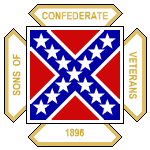Dodge Daytona racecars
#1

Posted 06 January 2011 - 02:02
And how long did they race Nascar for before being banned. My memory says only a few races but I am a long way removed from that era.
#3

Posted 06 January 2011 - 02:11
NASCAR mandated restrictions on cars with aero advantages that negated the car's wing and nose shape.
Cris
The hi winged pointed nose Dodge Daytonas based on a Dodge Charger. Were they ever sold for road use? Or just built for motorsport as were a few other cars from that mid 60s period?
And how long did they race Nascar for before being banned. My memory says only a few races but I am a long way removed from that era.
#4

Posted 06 January 2011 - 02:21
The body style was built onto quite a few street cars, all in the near-fluorescent colors some Chrysler cars sported at that time.The hi winged pointed nose Dodge Daytonas based on a Dodge Charger. Were they ever sold for road use? Or just built for motorsport as were a few other cars from that mid 60s period?
And how long did they race Nascar for before being banned. My memory says only a few races but I am a long way removed from that era.
This one was at the La Jolla Classic a few Januaries ago:

I didn't pay enough attention to know about their tenure in NASCAR competition. Gurney is second in this Mike Smith photo made at the entrance to Riverside (CA) International Raceway's Turn Eight.

#5

Posted 06 January 2011 - 04:50
They ran for two years in NASCAR with the big-block engines.The hi winged pointed nose Dodge Daytonas based on a Dodge Charger. Were they ever sold for road use? Or just built for motorsport as were a few other cars from that mid 60s period?
And how long did they race Nascar for before being banned. My memory says only a few races but I am a long way removed from that era.
For ninety seventy-one they could only use a 305. One team tried that and was fully competitive, but only tried it in one race.
They ran longer in USAC and other sanctions, but I do not know how much longer.
#6

Posted 06 January 2011 - 05:08
Gurney is second in this Mike Smith photo made at the entrance to Riverside (CA) International Raceway's Turn Eight.
Shortcutting from turn 6 to turn 8 totally avoiding turn 7.
#7

Posted 06 January 2011 - 17:04
Tom
#8

Posted 06 January 2011 - 19:46
#9

Posted 07 January 2011 - 00:05
Here's one that's just lying around:
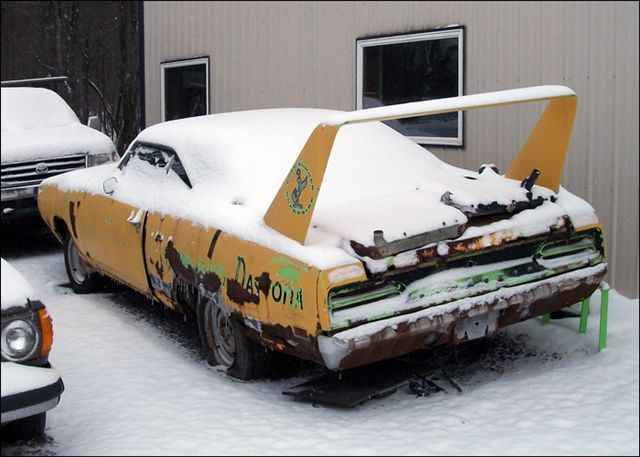
Edited by Ray Bell, 07 January 2011 - 00:07.
#10

Posted 07 January 2011 - 01:51
The hi winged pointed nose Dodge Daytonas based on a Dodge Charger. Were they ever sold for road use? Or just built for motorsport as were a few other cars from that mid 60s period?
And how long did they race Nascar for before being banned. My memory says only a few races but I am a long way removed from that era.
They were never banned. NASCAR had a 3 model year limit at the time, which meant that the 1969 Daytonas were only eligible for 1969, 1970, and 1971, to begin with. The 305 ci limit really cramped their competitiveness in what was going to be their final season anyway.
The Plymouth Superbird looks a lot like the Daytona, but was built on the Roadrunner platform, and so was not identical. It debuted in 1970, and was what brought Petty back to Plymouth after a year with Ford, caused by Chrysler's unwillingness to let him run a Daytona in 1969, or to build a Superbird for 1969.
#11

Posted 07 January 2011 - 05:13
Totally different cars, except both had pointed noses and wings.What I didn't know until I saw an article about them was that the Dodge and Plymouth cars were slightly different as regards both nose and wing. Seemed bizarre - but shows the industry still had some distinct independence even then and it wasn't pure "badge engineering".
The Superbird even had a rear window that differed from the non-aero version of Plymouth.
#12

Posted 07 January 2011 - 05:36
The car ended up as another Dukes of Hazad clone instead. The standard body work was fine and he had no troubles wih rego.
As Nascar I had heard they were frowned upon because of the wild panels and had a very short life. Obviuosly wrong.
#13

Posted 07 January 2011 - 06:23
Jesper
#14

Posted 07 January 2011 - 07:34
#15

Posted 07 January 2011 - 07:46
#16

Posted 07 January 2011 - 13:23
http://www.aerowarriors.com/bv.html
As mentioned above lets not forget about Ford's entry:
http://www.flickr.co...gal/3154895416/
My brain is locked up on whether GM produced a vehicle to counter Ford and Chrysler. Can not remember.............................or was all of this taking place during a GM ban on stock car racing?
#17

Posted 07 January 2011 - 15:35
My brain is locked up on whether GM produced a vehicle to counter Ford and Chrysler. Can not remember.............................or was all of this taking place during a GM ban on stock car racing?
Quite sure that a GM "Aero" was never raced during this period, as it was FoMoCo vs. Mopar with the odd privateer General. GM must have relied on Can-Am and Trans-Am for publicity.
Jesper
#18

Posted 07 January 2011 - 16:05
That's a big step up!The car ended up as another Dukes of Hazzad clone instead.
Tom
#19

Posted 07 January 2011 - 18:32
At this point in time the GM racing ban wass in FULL, effect, but a there was noo GM back-door, each was totally separate and any back door effort was secret to all except the few getting around the ban.My brain is locked up on whether GM produced a vehicle to counter Ford and Chrysler. Can not remember.............................or was all of this taking place during a GM ban on stock car racing?
Chevy did have a back door effort a year or so later, that brought grand success and some Pontiac gents gave it a shot also.
The closest to an "aero" car Chevy had, was a Late Model division car later one that looked like the front of a Ford Talledega on a Monte Carlo.
The officials let it run before they said, that ain't right.
IF you sift through all the pictures, there is a picture of it in one the threads at the H.A.M.B. siite.
Edited by Bob Riebe, 07 January 2011 - 23:23.
Advertisement
#20

Posted 07 January 2011 - 22:26
Of course there was the legendary Smokey Yunick Chevelle: http://www.circletra...elle/index.htmlQuite sure that a GM "Aero" was never raced during this period, as it was FoMoCo vs. Mopar with the odd privateer General. GM must have relied on Can-Am and Trans-Am for publicity.
Jesper

#21

Posted 07 January 2011 - 23:11
Part of my reason asking about road use is that i know of a person who tried to register a Dodge Daytona clone and they would not register it here claiming among other things that the wing was [and it is] a dangerous protrusion. And they did not recognise the nose either. Though I think that was a fibreglass replica.The car was a well finished, properly restored car.
The car ended up as another Dukes of Hazad clone instead. The standard body work was fine and he had no troubles wih rego.
As Nascar I had heard they were frowned upon because of the wild panels and had a very short life. Obviuosly wrong.
The Daytona was legal in all fifty states as a 1969 model. There should be no problem registering a real one or a clone. As to the Superbird which was built months later as a 1970 model, there were two US states that stated they were illegal because of bumper laws. Maryland was one of them. Back then, a few people installed rudimentary bumpers to get around this. Today it is not a problem anywhere that I know of.
In NASCAR, the whole business of Ford and Chrysler building special aerodynamic cars was spiraling out of control. Bill France was not a fan of these cars. While they were not outright banned for 1971, they were hamstrung with the 305 engine, as were the Ford Talladegas, etc. NASCAR did this thinking that nobody would attempt to race that combination. However Chrysler did try it - and it did work well enough at Daytona. After that, NASCAR quietly told the Chrysler people not to bring the car to the next speedway race. The reality is that the small engine car would have only been competive at Daytona or Talladega.
While the aerodynamic bodied cars were done in NASCAR in 1971, they were legal to race the three year cycle in the USAC stock car series. So Daytonas were eligible through 1971 and Superbirds through the end of 1972.
#22

Posted 07 January 2011 - 23:19
Another difference betwin the Dodge Daytona and Plymouth Superbird was the number of cars build in the first place. The Dodge only had to be build in 500 units, as did the Ford Torino, but the rules were changed for 1970. Now a body shape had to be build to the number of dealerships across the US. In case of the Plymouth that amounted to +2000! From what I know a lot of these 2000 cars ended up having the nose and wing removed in order to sell them at all.
Jesper
As you mentioned, to discourage the production of special bodies, the homologation rules were changed from 500 cars in 1969, to 1000 cars or one for every two dealers, whichever was greater. Thus, Chrysler had to build almost 2000 Superbirds. Had Ford gone on with their King Cobra project, they would have had to build almost 3000 cars.
The Superbirds were indeed a harder sell than the 500 Daytonas. But the amount of cars that were converted back to standard cars was very small. In 35 years of involvement with these cars, I can count the number of cars taken back to stock configuration on my hands. This is one of those stories that seems to get larger as time goes on. Rather than continue to pay floorplanning on the cars, or the expense and labor of converting them backwards, dealers simply cut the prices. Most Birds were gone by the end of 1970, but there were exceptions in some rural areas.
#23

Posted 07 January 2011 - 23:32
What I didn't know until I saw an article about them was that the Dodge and Plymouth cars were slightly different as regards both nose and wing. Seemed bizarre - but shows the industry still had some distinct independence even then and it wasn't pure "badge engineering".
Virtually no body parts interchange on the cars, including the nose, wing, rear window or fender scoops. Some of this was due lessons learned on the Daytona months prior to the Superbird. Some was due to the Dodge and Plymouth having two different sets of basic body panels. Some was due to the increased involvement of the styling people on the Superbird.
In the case of the Daytona, the car was designed by the aerodynamics group within Chrysler. The Styling departments involvement was limited to paint and stripes. The styling people were aghast at the Daytona. But they were shut out by Dodge president Bob McCurry who operated with complete authority and made it clear the styling people were to remain uninvolved unless it meant making the car go faster.
The Plymouth division did not have a man in control like Bob McCurry, and when the decision was made to do the Superbird, the styling people were much more involved. Because of the basic non fastback body, the rear window of the Superbird is a compromise and aerodynamically deficient to the Daytona. The rear wing is swept rearward more for appearance and a minor aerodynamic benefit. The Superbird nose has the air intake on the bottom for appearance, and is larger for greater cooling effect. The Superbird uses modified Dodge Coronet front fenders because they were easy to line up with the nose cone.
Edited by Aero426, 07 January 2011 - 23:36.
#24

Posted 08 January 2011 - 01:04
The Daytona was legal in all fifty states as a 1969 model. There should be no problem registering a real one or a clone.
Lee didn't mention that he was from Australia, not the US.
#25

Posted 08 January 2011 - 01:18
Lee didn't mention that he was from Australia, not the US.
There are a few Daytonas and Superbirds in Australia and New Zealand.
Do they require a visual inspection of the car to register it in Australia?
#26

Posted 08 January 2011 - 09:19
Thank you to Aero426 for correcting my retelling of dealer convertions of Superbirds. It sounded strange to me, as such an operation would likely be both time consuming and costly.
Jesper
#27

Posted 08 January 2011 - 09:29
#28

Posted 08 January 2011 - 11:25
Of course there was the legendary Smokey Yunick Chevelle: http://www.circletra...elle/index.html
I was faintly thinking of Smokey, but it took to, what, 1972? before Junior Johnson entered a Monte Carlo, before GM once again became a force in NASCAR. Thank you for the link btw. Is the Smokey book still available?
Jesper
#29

Posted 08 January 2011 - 12:08
Yes, full inspection. Done by government beurocrats who have little idea of the real world of motoring. With wings etc they will not pass them unless it is factory, In the case of the Daytona I dont think he had enough proof that Chrysler built them that way.The car was a 318 Charger built as a clone.But a properly restored car.There are a few Daytonas and Superbirds in Australia and New Zealand.
Do they require a visual inspection of the car to register it in Australia?
#30

Posted 08 January 2011 - 13:18
Dear Jesper, I think you will struggle to find a new copy of Smokey's autobiography in Denmark (or the UK) but I have seen second-hand copies advertised for silly prices (£500+). However it looks as if new copies of the three volume "Racer's Edition" of Best Damn Garage in Town are still available for $95 from Carbon Press (the publishing company set up by Smokey) in the USA. Carbon Press has also produced two audio books (Sex, Lies & Superspeedways and More Sex, Lies & Superspeedways) comprising excerpts from Smokey's autobiography read by (amongst others) John Z DeLorean!I was faintly thinking of Smokey, but it took to, what, 1972? before Junior Johnson entered a Monte Carlo, before GM once again became a force in NASCAR. Thank you for the link btw. Is the Smokey book still available?
Jesper
Go to http://shop.carbonpr...ine.com/main.sc for more information.
Update: sorry Jesper - it appears that Carbon Press don't ship to customers outside the USA & Canada
Edited by Amphicar, 08 January 2011 - 21:31.
#31

Posted 08 January 2011 - 20:02
The car in Ray's photo, while having "Daytona" painted on the fender, is actually a Plymouth Superbird judging by the tailights.
That is correct. That particular car has just been rescued by a friend in New Jersey. It is quite rusty and crusty. It is an original lime green car which is one of the more favored colors.

Edited by Aero426, 08 January 2011 - 20:04.
#32

Posted 08 January 2011 - 20:17
Does anybody have cW values for the Daytona and Superbird, both street and racing? Furthermore, were these cars used in any kind of road racing? - I would think that the sheer size would prevent either from being competitive.
Thank you to Aero426 for correcting my retelling of dealer convertions of Superbirds. It sounded strange to me, as such an operation would likely be both time consuming and costly.
Jesper
The Daytona was said to be .29 and the Superbird slightly higher. They were raced on road courses like Riverside, Sears Point and Indianapolis Raceway Park. About the shortest track they raced on was the flat mile oval at Milwaukee, where the wing cars were said to hold a slight handling advantage.
As to the conversions, it is one of those legends that gets bigger as time goes on. Sort of like, "the older I get, the faster I was".
#33

Posted 08 January 2011 - 20:34
Don't forget Jesper, they are the same size as the other cars against which they competed.Does anybody have cW values for the Daytona and Superbird, both street and racing? Furthermore, were these cars used in any kind of road racing? - I would think that the sheer size would prevent either from being competitive.
Jesper
They ran more road races in USAC races than NASCAR.
On high speed road courses, the wings may have given them a smal advantage.
#34

Posted 09 January 2011 - 06:26
Don't forget Jesper, they are the same size as the other cars against which they competed.
They ran more road races in USAC races than NASCAR.
On high speed road courses, the wings may have given them a smal advantage.
With road races I meant IMSA and the like - badly explained by me in the post, but anyway - were these batmobiles ever used outside oval racing, stock car oriented racing?
Jesper
#35

Posted 09 January 2011 - 06:39
Not that I know of; by the time the IMSA had a class for such cars, they were not legal anymore.With road races I meant IMSA and the like - badly explained by me in the post, but anyway - were these batmobiles ever used outside oval racing, stock car oriented racing?
Jesper
#36

Posted 09 January 2011 - 07:10
Not that I know of; by the time the IMSA had a class for such cars, they were not legal anymore.
Porsche 914s were raced well into the 1980s in IMSA GTU competition, sow what IMSA saw as legal must have been rather larger than the three years from production as of NASCAR.
Jesper
#37

Posted 09 January 2011 - 07:32
France and Bishop did not work out a inter-change till late in the seventies, long after anyone had used a winged car in competition.Porsche 914s were raced well into the 1980s in IMSA GTU competition, sow what IMSA saw as legal must have been rather larger than the three years from production as of NASCAR.
Jesper
Neither Ford nor Dodge had any interest in reviving a seven to eight year old car, but several stock cars of then current vintage were constructed.
#38

Posted 09 January 2011 - 23:46
The Dodge Charger, the Dodge Cornet, The Dodge "Super B", the Plymouth GTX, The Plymouth Road Runner, And the Plymouth "Super Bird" were all Chrysler "B" Body cars. As such they all shared essentially the entire frame and the majority of the body components, along with the Suspension, brakes, and general power train options. Yes they were built in different plants, and grills, taillights and trim pieces certainly were different, but basically they shared the same key components.The Plymouth Superbird looks a lot like the Daytona, but was built on the Roadrunner platform, and so was not identical. It debuted in 1970, and was what brought Petty back to Plymouth after a year with Ford, caused by Chrysler's unwillingness to let him run a Daytona in 1969, or to build a Superbird for 1969.
Saying they were different is really a bit of a stretch.
That is like saying the "A Body" Dodge Dart and the Plymouth Valiant were "different" from each other. Yeah right.
(for those who don't understand the "Yeah, right" comment, I am being sarcastic.
#39

Posted 10 January 2011 - 00:13
Tell me which parts of a Dodge Charger inter-changed with the Super-Bird.The Dodge Charger, the Dodge Cornet, The Dodge "Super B", the Plymouth GTX, The Plymouth Road Runner, And the Plymouth "Super Bird" were all Chrysler "B" Body cars. As such they all shared essentially the entire frame and the majority of the body components, along with the Suspension, brakes, and general power train options. Yes they were built in different plants, and grills, taillights and trim pieces certainly were different, but basically they shared the same key components.
Chassis were similar, and yes, Chrysler had stopped offering differing drive trains a decade earlier, but that is all, well maybe the window crank handles.
The Coronet, Plymouth GTX and sub-types were different bodies of similar vehicles.
Hmm, by what you say as the Falcon and Mustang were based on a similar chassis, so they are the same thing also? OHHH, the humanity!
Advertisement
#40

Posted 10 January 2011 - 03:01
Tell me which parts of a Dodge Charger inter-changed with the Super-Bird.
Chassis were similar, and yes, Chrysler had stopped offering differing drive trains a decade earlier, but that is all, well maybe the window crank handles.
The Coronet, Plymouth GTX and sub-types were different bodies of similar vehicles.
Hmm, by what you say as the Falcon and Mustang were based on a similar chassis, so they are the same thing also? OHHH, the humanity!
Bob is correct in that there is no sheet metal that will interchange between a Dodge Charger and Plymouth Road Runner. Although both are Chrysler B-bodies and share the same basic unibody platform and suspension on the street, aerodynamically, both of the stock donor cars have some differences.
Edited by Aero426, 10 January 2011 - 03:09.
#41

Posted 10 January 2011 - 07:02
And a Dodge and Plymoth are very similar in comparison to Mustang V Falcon.
#42

Posted 10 January 2011 - 09:59
http://www.carsinbar...tonas/index.htm
#43

Posted 10 January 2011 - 12:42
For those of you looking for that "Barn Find" Superbird, check out this site:
http://www.carsinbar...tonas/index.htm
#44

Posted 10 January 2011 - 18:06
These are my twins. The green street car we have owned since 1972 and is unrestored. The race car is an authentic Grand National stock car. It is very original as well and other than a repaint in 1990 is as last raced in 1972.
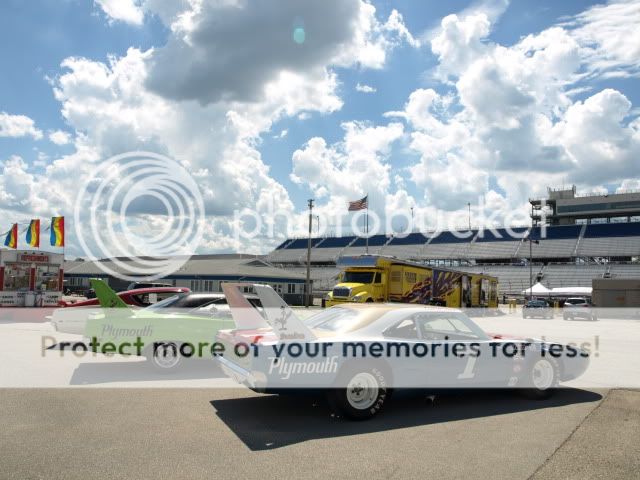
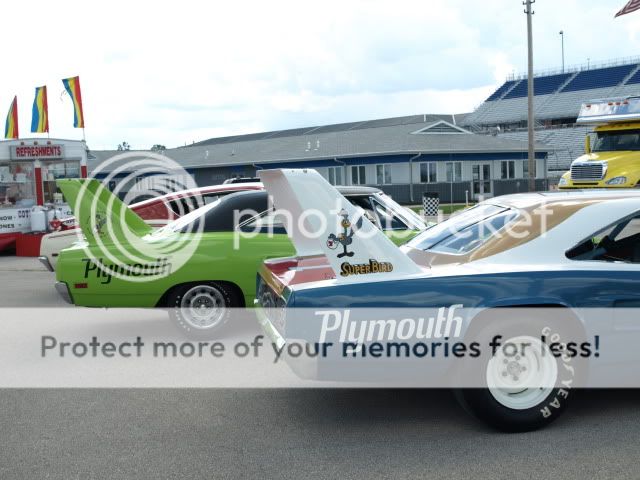
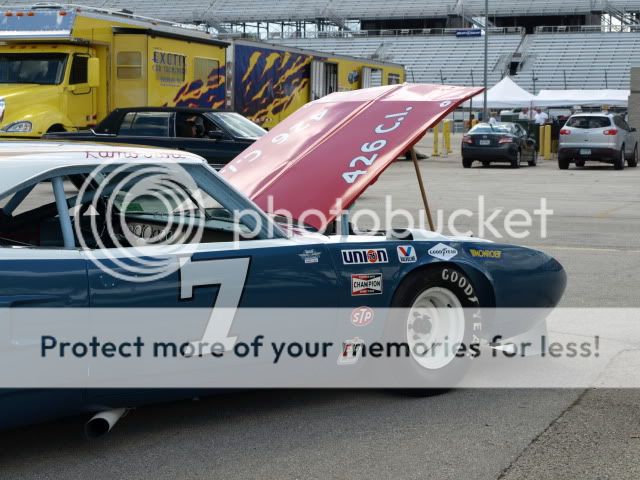
Edited by Aero426, 10 January 2011 - 18:07.
#45

Posted 10 January 2011 - 19:40
#46

Posted 10 January 2011 - 22:06
From my observations the other night the Dodge and Plymouth are similar cars with slightly different skinning, headlights and taillights. Plus trim ofcourse. But lots of parts would be the same and the basic tooling would have been very similar.And I think both cars I was looking at were both 69s. The GTX is quite different but also a bit newer, unless there is a 69GTX.
And a Dodge and Plymouth are very similar in comparison to Mustang V Falcon.
1969, was a model change year, in both makes.
Wth all due respect, either you are looking a Dodge Coronet, or you need glasses.
The Plymouth had a 116 in. wheelbase and the Charger a 117 but I suppose unless one has sat in or stood by one, pictures can be deceiving.
--------------------------------------------
Addendum:
Here is what Ford had ready for round two, and Chrysler was also working on follow-up aero cars.

Edited by Bob Riebe, 10 January 2011 - 22:18.
#47

Posted 11 January 2011 - 18:10
Amazing - never seen this before. It looks a little like a Lotus Elan Fastback Coupe on steroids!1969, was a model change year, in both makes.
Wth all due respect, either you are looking a Dodge Coronet, or you need glasses.
The Plymouth had a 116 in. wheelbase and the Charger a 117 but I suppose unless one has sat in or stood by one, pictures can be deceiving.
--------------------------------------------
Addendum:
Here is what Ford had ready for round two, and Chrysler was also working on follow-up aero cars.
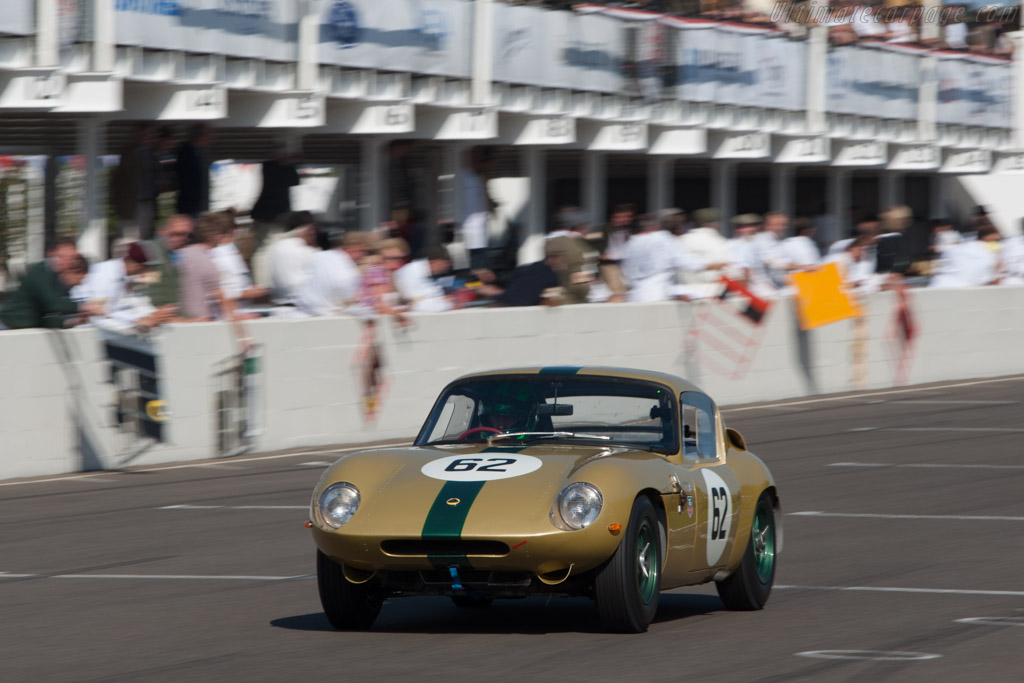
Getting back to the winged wonders, it surprised me that Dan Gurney did much of the development testing of the Superbird and finished 6th in one at the Riverside 500.
I'd always thought of DSG as essentially a Ford man.
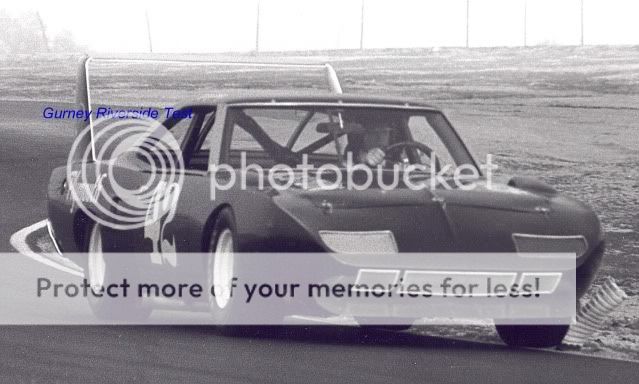
#48

Posted 11 January 2011 - 18:27
The Chrysler race engineering people were thrilled with the feedback they received from Dan. On one test they were at Riverside with Gurney and Bobby Isaac. In the evening, the engineering people continued to pay so much attention to Gurney that Isaac didn't even show up to test the following day. He was angry. It was eventually determined that without telling anyone, he had checked out of his motel room and flew home. Trouble was, Gurney wasn't going to be there either as he had another race committment! So the test team was left hanging there.
Edited by Aero426, 11 January 2011 - 18:36.
#49

Posted 13 January 2011 - 21:35
Some pretty impressive autographs too!

#50

Posted 14 January 2011 - 03:24
If they were mine I wouldn't want drivers autographs on them who never drove that particular model of car.Some pretty impressive autographs too!








